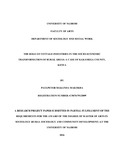| dc.description.abstract | Cottage industries, also referred to as household-based industries in this research study, are production units mostly based in homesteads, which make use locally available raw materials, are driven by fuel or manual power and skills, and whose products end up in the local market.
The general objective of this research study was to examine the role of household-based industries in the socio-economic transformation of rural areas, basing its conclusions and recommendations on a case study of Kakamega County, Kenya. The specific objectives were: to document the forms of household-based industries existing in Kakamega County; to highlight the profiles of household-based industry proprietors and labourers in Kakamega County, and to assess the contribution of the household-based industries in Kakamega County in the creation of wealth. A sample size of 226 respondents was used for the study. Manda, Mukhonje and Kivaywa sub-locations were assigned 70, 82 and 74 respondents through proportionate random sampling. Systematic random sampling was applied in each of the sub-locations.
The household-based industries documented in this study were: earthenware production, unrefined sugar production, brick production, liquor generation, stone-works, woodworks, herbal medicine extraction, charcoal burning, weaving, pastry production, cycle repair, flour production and shoe production and repair. The profiles of household-based industry proprietors and labourers looked into include: the reason for location of industry, mode of ownership, duration of ownership, duration of employment, state of the industry, nature of employment, type of employment and change in the number of labourers. Household-based industries carry out a key role in the socio-economic transformation of the rural zones in Kenya.
Seventy-two percent of household-based industry proprietors invested using income generated while 28 percent did not. Therefore, these industries created wealth through investment. Most household-based industries (66 percent) employed 2-4 labourers whereas 15 percent of them employed more than four labourers. In other words, jobs were created by these industries. | en_US |

